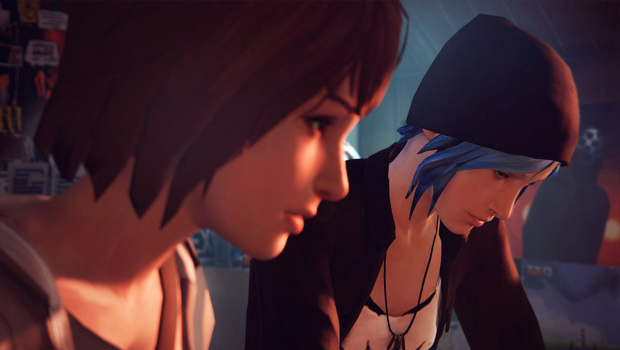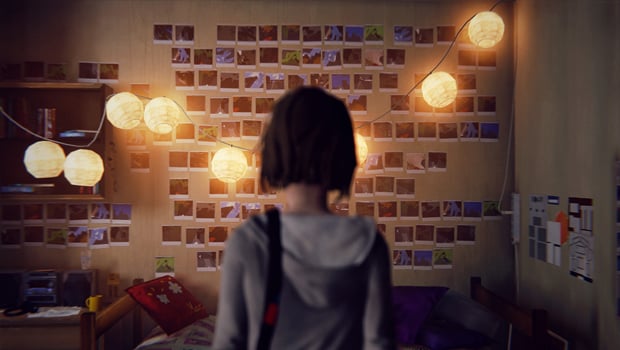Once More With Feeling
Life is Strange is the newest offering from RPG giant Square-Enix and Dontnod, the development studio that brought us Remember Me . It’s best described as a cinematic game following in the traditions of Heavy Rain and The Walking Dead . It also tries very hard to give off an indie movie sort of vibe, telling a deeply personal story of a high schooler, reflecting on her choices as she makes her way through life. However, certain design choices both make the game more interesting and less compelling to play. Life is Strange seems to constantly be battling against its own concept. When it wins, it’s a fantastically artistic experience, but the struggle to show that artistic side can sometimes pull you out of the experience.
Life is Strange follows the adventures of Maxine Caulfield. Max is a photography student who left town five years ago to pursue her career as an artist. She recently has come back to her hometown of Arcadia, Oregon after a short time of living in Seattle, on a scholarship that allows her to attend an elite school for the arts. Unfortunately, life has changed in the past five years, and the choices that Max and her friends have made will forever change her future. Her relationships are not what they used to be, her friends have grown distant, and even the town itself seems to have a darkness about it, as missing persons posters and acts of school violence are becoming commonplace. You guide Max through all of this as she makes new relationships and attempts to find her place in the world.
Oh yeah… and you can rewind time.
On the surface, Life is Strange plays like any other Telltale-style adventure game. You walk around an area looking at things, touching things, picking up things, and speaking to people. There is some light puzzle solving, a lot of dialogue, and important moral choices that affect the plot. In this respect the game does well.
But after an early scene, Max realizes that she has the power to rewind time in order to change the past. The way Max realizes she has this power is a little forced and contrived, and the first few scenes where she experiments with it are incredibly awkward, but that can be forgiven. What is a bit harder to overlook is how this affects the rest of the gameplay.

There are two main ways in which this power is used. The first is the aforementioned puzzle solving. Max’s inventory and memory are not affected by rewinding time. The game will frequently have you pick up items that only become available after some catastrophe, then rewind time only to use that item in order to prevent said catastrophe. Similarly, you may find yourself getting railroaded down undesirable outcomes in dialogue trees, but these outcomes reveal new information that you can then use earlier in the conversation if you rewind. These puzzles are never really hard, only requiring rewinding a couple seconds at most in order to fix everything up, but they do give you a couple of neat “aha” moments. In this respect, the time rewinding mechanic works quite well.
The second way that your time powers are used is a little less rewarding. Much like in Telltale games, you will come to points where your actions or dialogue decisions will change the direction of the plot. You’ll be notified of this in the standard Telltale manner, through a dialogue box at the top left of the screen that says “he will remember this” or “she noticed you are uneasy” or something like that. In cinematic games, these are the big points in which you feel like you have an impact on the world around you. You made a decision and you have to stick to it.

Except you don’t have to stick to it in Life is Strange. Every time you make a serious choice, you can see the immediate effects of it, then just rewind if you don’t like it. Then you go through the dialogue again choose the other choice, see the other consequences, and you can go back again if you still don’t like them. It kind of puts training wheels on the whole idea of a cinematic game. You never make the wrong choices now, and more importantly it feels extra cheap when both choices you can make are bad. In this way, the time reversal mechanic actually makes the game less compelling.
That’s not to say Life is Strange is bad. On the contrary, there are lots of good design elements here. Character design, in particular, is amazing. The many characters in Max’s high school feel like real people, not just stereotypes. Sure, you’ll get the snooty rich kids, the shy geeks, the punks, the outcasts, and the athletes, but as you continue to talk to these characters they feel as if they are less 80s movie stereotypes and more living breathing human beings. Teachers stammer over themselves and sometimes get hung up on their own lessons. Kids gossip in a natural way. The world feels living, not just a construct in service to the main character’s progression to the plot. This alone is a triumph in world building.
The game’s sound is also top notch. Not only is all of the voice acting very effective in conveying emotion, but the game’s use of its soundtrack is leagues beyond other titles on the market. It does a lot more than just fade music in and out as appropriate. It uses it to convey emotion in interesting ways. For example, right at the beginning of the game a different song plays when Max puts on her headphones, at a slightly higher volume, with everyone’s speech drowned out by the music. This really gets you into Max’s body and makes you feel like part of the world.

As far as controls go, it’s pretty much you would expect. Walk with the analog stick, press buttons to make choices, same old, same old. The keyboard and mouse controls are a little awkward, forcing you to click, hold, and drag to choices in order to make them. You have a button for rewinding time, a button for jumping backward to the last choice you made, a button for jumping forward to the next choice you have to make, and a run button. It’s all easy and intuitive to get ahold of.
I did have fun with Life is Strange , but there are a lot of questions left unanswered at the end of Episode 1 . I’m not even really sure what sort of game I am playing yet, in terms of story genre. It opens up in this bleak storm-riddled landscape, but then the rest of the game feel more like something out of a college drama. I think further episodes will probably be better, as the development team starts to realize what story they want to tell. They can also rein in the time powers a bit, allowing them to be used more in problem solving and less in decision making. I think if this is done, the game can rival Telltale’s cinematic games, which is appropriate considering they take so much from the Telltale formula, right down to the statistics page which shows off what choices you made at the end of the episode.
Life is Strange is an interesting attempt to break into the cinematic genre. It’s certainly unique, blending together gameplay elements of Telltale’s and Quantic Dreams’ productions with more “gamey” elements such as it’s time rewinding mechanics. It shows a lot of promise as an episodic game, but there are certain mechanics that leave me feeling a bit skeptical for this franchise’s future. I think Episode 1 is worth a play through, but whether or not this becomes a fantastic multi-episode game will depend on the choices the developers make from here on out. Considering the game’s subject matter, that seems entirely appropriate.
RATING OUT OF 5 RATING DESCRIPTION 4.0 Graphics
Though sometimes the lighting makes hair and features seem plastic, on the whole faces are expressive and models move in a believable way. 3.8 Control
The PC controls are a little wonky, involving lots of clicks and drags, but the game works just fine on a controller. 4.5 Music / Sound FX / Voice Acting
The soundtrack and voice acting are probably the best parts of the game. 4.0 Play Value
It’s worth playing just to see what further episodes have in store. 3.9 Overall Rating – Good
Not an average. See Rating legend below for a final score breakdown.
| Review Rating Legend | |||
|---|---|---|---|
| 0.1 – 1.9 = Avoid | 2.5 – 2.9 = Average | 3.5 – 3.9 = Good | 4.5 – 4.9 = Must Buy |
| 2.0 – 2.4 = Poor | 3.0 – 3.4 = Fair | 4.0 – 4.4 = Great | 5.0 = The Best |
Game Features:
